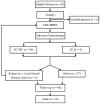Cytoreductive surgery plus hyperthermic intraperitoneal chemotherapy improves survival for patients with peritoneal carcinomatosis from colorectal cancer: a phase II study from a Chinese center
- PMID: 25259574
- PMCID: PMC4178169
- DOI: 10.1371/journal.pone.0108509
Cytoreductive surgery plus hyperthermic intraperitoneal chemotherapy improves survival for patients with peritoneal carcinomatosis from colorectal cancer: a phase II study from a Chinese center
Abstract
Background: Peritoneal carcinomatosis (PC) is a difficult clinical challenge in colorectal cancer (CRC) because conventional treatment modalities could not produce significant survival benefit, which highlights the acute need for new treatment strategies. Our previous case-control study demonstrated the potential survival advantage of cytoreductive surgery (CRS) plus hyperthermic intraperitoneal chemotherapy (HIPEC) over CRS alone. This phase II study was to further investigate the efficacy and adverse events of CRS+HIPEC for Chinese patients with CRC PC.
Methods: A total of 60 consecutive CRC PC patients underwent 63 procedures consisting of CRS+HIPEC and postoperative chemotherapy, all by a designated team focusing on this combined treatment modality. All the clinico-pathological information was systematically integrated into a prospective database. The primary end point was disease-specific overall survival (OS), and the secondary end points were perioperative safety profiles.
Results: By the most recent database update, the median follow-up was 29.9 (range 3.5-108.9) months. The peritoneal cancer index (PCI) ≤20 was in 47.0% of patients, complete cytoreductive surgery (CC0-1) was performed in 53.0% of patients. The median OS was 16.0 (95% confidence interval [CI] 12.2-19.8) months, and the 1-, 2-, 3-, and 5-year survival rates were 70.5%, 34.2%, 22.0% and 22.0%, respectively. Mortality and grades 3 to 5 morbidity rates in postoperative 30 days were 0.0% and 30.2%, respectively. Univariate analysis identified 3 parameters with significant effects on OS: PCI ≤20, CC0-1 and adjuvant chemotherapy over 6 cycles. On multivariate analysis, however, only CC0-1 and adjuvant chemotherapy ≥6 cycles were found to be independent factors for OS benefit.
Discussion: CRS+HIPEC at a specialized treatment center could improve OS for selected CRC PC patients from China, with acceptable perioperative safety.
Conflict of interest statement
Figures


Similar articles
-
Effect of hyperthermic intraperitoneal chemotherapy in combination with cytoreductive surgery on the prognosis of patients with colorectal cancer peritoneal metastasis: a systematic review and meta-analysis.World J Surg Oncol. 2022 Jun 14;20(1):200. doi: 10.1186/s12957-022-02666-3. World J Surg Oncol. 2022. PMID: 35701802 Free PMC article.
-
[Efficacy of 1 384 cases of peritoneal carcinomatosis underwent cytoreductive surgery plus hyperthermic intraperitoneal chemotherapy].Zhonghua Wei Chang Wai Ke Za Zhi. 2021 Mar 25;24(3):230-239. doi: 10.3760/cma.j.cn.441530-20201110-00603. Zhonghua Wei Chang Wai Ke Za Zhi. 2021. PMID: 34645167 Chinese.
-
Cytoreductive surgery plus hyperthermic intraperitoneal chemotherapy improves survival of patients with peritoneal carcinomatosis from colorectal cancer: a case-control study from a Chinese center.J Surg Oncol. 2014 Jun;109(7):730-9. doi: 10.1002/jso.23545. Epub 2013 Dec 27. J Surg Oncol. 2014. PMID: 24374987 Free PMC article.
-
Cytoreductive surgery plus hyperthermic intraperitoneal chemotherapy with lobaplatin and docetaxel to treat synchronous peritoneal carcinomatosis from gastric cancer: Results from a Chinese center.Eur J Surg Oncol. 2016 Jul;42(7):1024-34. doi: 10.1016/j.ejso.2016.04.053. Epub 2016 May 3. Eur J Surg Oncol. 2016. PMID: 27179924
-
Cytoreductive surgery and intraperitoneal chemotherapy for treatment of peritoneal carcinomatosis from colorectal origin.Clin Transl Oncol. 2014 Feb;16(2):128-40. doi: 10.1007/s12094-013-1053-x. Epub 2013 Jun 6. Clin Transl Oncol. 2014. PMID: 23740133 Review.
Cited by
-
Chinese expert consensus on cytoreductive surgery and hyperthermic intraperitoneal chemotherapy for peritoneal malignancies.World J Gastroenterol. 2016 Aug 14;22(30):6906-16. doi: 10.3748/wjg.v22.i30.6906. World J Gastroenterol. 2016. PMID: 27570426 Free PMC article. Review.
-
Systematic Review of Variations in Hyperthermic Intraperitoneal Chemotherapy (HIPEC) for Peritoneal Metastasis from Colorectal Cancer.J Clin Med. 2018 Dec 19;7(12):567. doi: 10.3390/jcm7120567. J Clin Med. 2018. PMID: 30572653 Free PMC article. Review.
-
Effect of hyperthermic intraperitoneal chemotherapy in combination with cytoreductive surgery on the prognosis of patients with colorectal cancer peritoneal metastasis: a systematic review and meta-analysis.World J Surg Oncol. 2022 Jun 14;20(1):200. doi: 10.1186/s12957-022-02666-3. World J Surg Oncol. 2022. PMID: 35701802 Free PMC article.
-
Treatment of hypermyoglobinemia after CRS + HIPEC for patients with peritoneal carcinomatosis: A retrospective comparative study.Medicine (Baltimore). 2017 Nov;96(45):e8573. doi: 10.1097/MD.0000000000008573. Medicine (Baltimore). 2017. PMID: 29137079 Free PMC article.
-
Hyperthermic intraperitoneal chemotherapy with cisplatin and mitomycin C for colorectal cancer peritoneal metastases: A systematic review of the literature.Pleura Peritoneum. 2019 May 29;4(2):20190006. doi: 10.1515/pp-2019-0006. eCollection 2019 Jun 1. Pleura Peritoneum. 2019. PMID: 31388562 Free PMC article. Review.
References
Publication types
MeSH terms
Substances
LinkOut - more resources
Full Text Sources
Other Literature Sources
Medical
Miscellaneous

